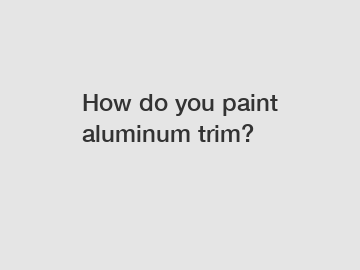How do you paint aluminum trim?
Aluminum trim is a versatile and durable material often used on windows, doors, and other fixtures in both residential and commercial buildings. Over time, aluminum trim can become faded or lose its original luster, requiring a fresh coat of paint to restore its appearance. If you are looking to paint aluminum trim, this article will guide you through the process of achieving a professional and long-lasting finish.
Preparation is Key.
Before you begin painting aluminum trim, thorough preparation is essential. Start by removing any existing paint or loose debris from the surface using a wire brush or sandpaper. This step ensures that the new coat of paint adheres properly to the trim. Next, thoroughly clean the trim with a mild detergent or a specialized aluminum cleaner to remove any dirt, grease, or oxidation. Rinse the trim thoroughly and allow it to dry completely before proceeding.

Choosing the Right Paint.
When it comes to painting aluminum trim, selecting the right paint is crucial for a successful outcome. Opt for a high-quality exterior paint specifically designed for use on metals. Look for paints labeled as "acrylic" or "latex," as they provide excellent adhesion and durability. Additionally, consider choosing a paint formulated with built-in rust inhibitors to protect the aluminum from corrosion. It is also advisable to select a paint color that complements the overall aesthetics of your property.
Applying the Paint.
1. Apply a Coat of Primer: Before painting your aluminum trim, it is recommended to apply a coat of primer. This step helps the paint adhere more effectively and ensures an even finish. Use a brush or a roller to apply a thin and even layer of primer, following the manufacturer's instructions. Allow the primer to dry completely before proceeding to the next step.
2. Paint the Trim: When it comes to painting aluminum trim, a brush is generally the preferred tool. Ensure that the brush you choose is appropriate for the size of the trim and provides good coverage. Begin by applying paint to the corners and edges, working your way along the length of the trim. Apply thin and even coats of paint, allowing each coat to dry before applying the next one. Avoid applying thick coats as they can lead to drips and an uneven finish.
3. Allow the Paint to Cure: After the final coat of paint has been applied, allow it to cure fully according to the manufacturer's instructions. Curing time often varies depending on the paint brand and environmental conditions. It is crucial to follow these instructions to ensure the longevity and durability of the paint finish.
Maintaining the Painted Trim.
Once the aluminum trim has been successfully painted, it is important to regularly maintain and care for it. Avoid using abrasive cleaners or tools that can damage the painted surface. Instead, clean the trim gently with a mild detergent and a soft cloth. Regularly inspect the trim for any signs of chipping, cracking, or peeling, and promptly address any issues to prevent further damage.
In conclusion, painting aluminum trim can be a relatively straightforward process if done correctly. By following the steps outlined in this article, you can achieve a professional and long-lasting finish that enhances the overall aesthetics of your property. Should you require any further assistance or have any questions, do not hesitate to contact us.
If you are looking for more details, kindly visit coil for gutters, high quality painted aluminium coil, powder coated aluminium flashings.


